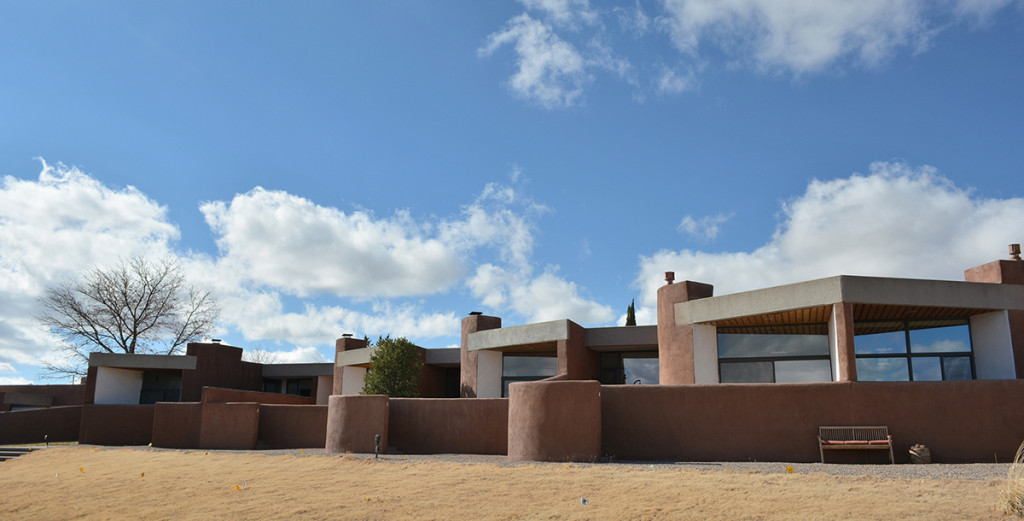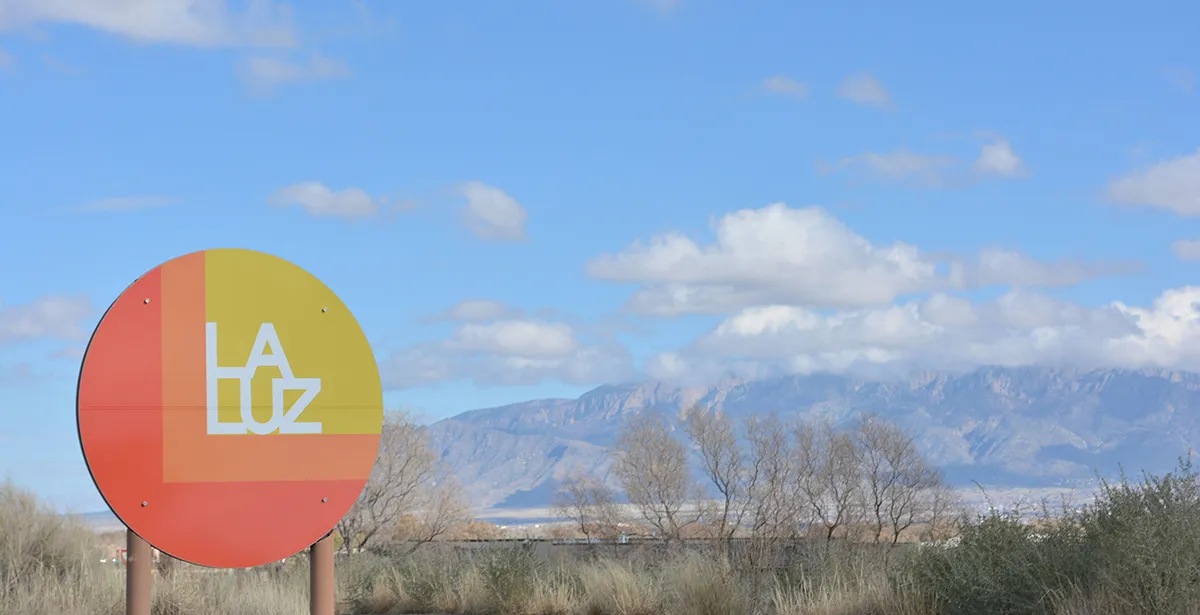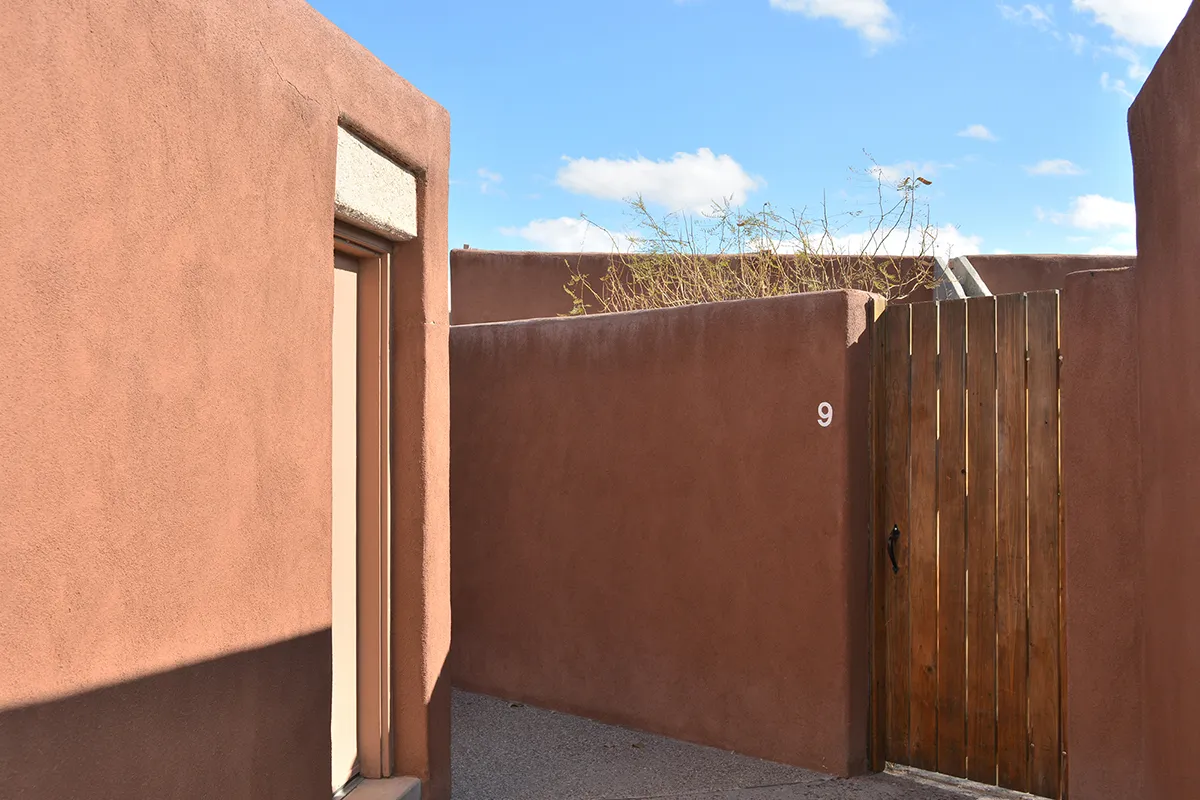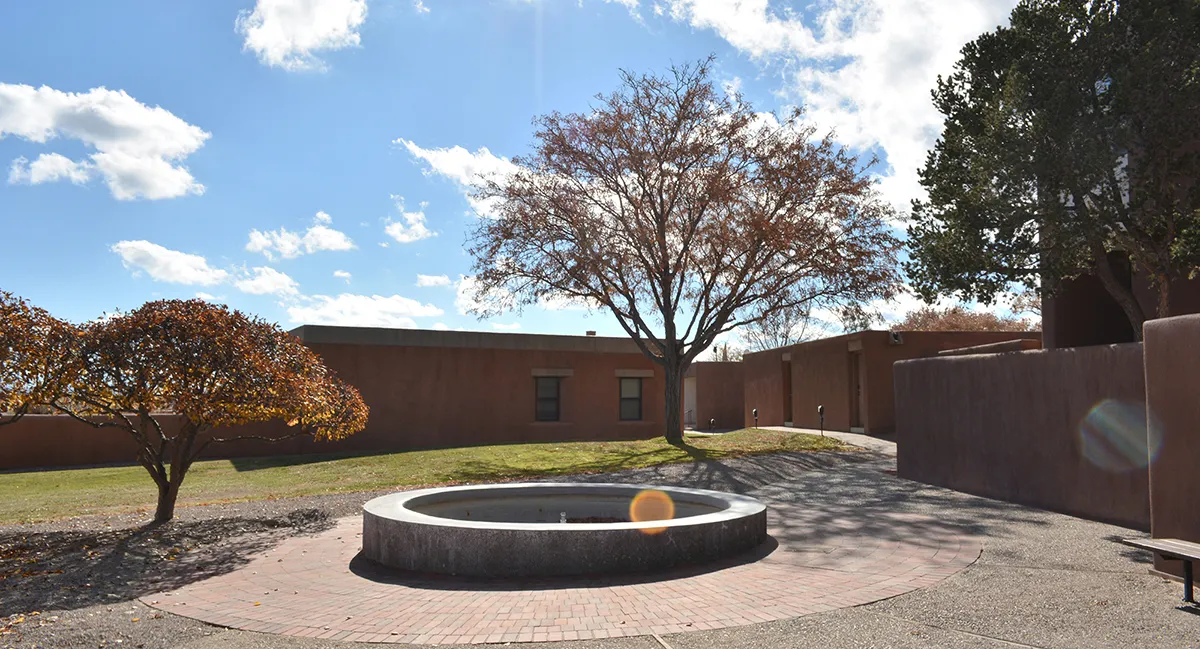1967-74
Antoine Predock
Case study by:
Mhd Alaa Eddin Arar,Fri Oct 09 2015
La Luz

It was when I was a student traveling in Spain on a motorbike in the 1960s that I first encountered the Alhambra. I had a limited understanding of Moorish architecture, since at that time architectural history courses to which I had been exposed barely touched on non-Western models. This moving, unforgettable encounter revealed a spatial realm that inalterably affected my path in architecture. Antoine Predock, 2002.1
Introduction
La Luz is a townhouse development on the western side of the city of Albuquerque, adjacent to the Rio Grande River. Designed by Antoine Predock, the project achieved great success and attracted wide attention due to its unique approach to materials, landscape, and planning. The community’s openness to nature, its unity with the land, and its adaptation to climate represented the foundation for a different type of regional architecture, and an alternative approach to the rapid suburban growth that Albuquerque experienced in the postwar period.
Between 1960 and 1970, the Albuquerque metropolitan area’s population increased by 54,000, reaching 244,000.2 It was only natural that new housing developments rose to respond to these demographic changes and, indeed, Albuquerque’s urban form changed dramatically in the postwar decades. Tract housing sprawled as merchant builders reshaped vast acreage at once, and movement into low-density areas became common amidst increased dependence on cars. The result was the decentralization of Albuquerque.
Ray Graham was the visionary land owner. Antoine Predock was the inspired architect. Didier Raven was the enthusiastic developer. La Luz Landowners Association.3
Graham, Raven, and Predock
The genesis of La Luz began when Ray Graham and Didier Raven, two Corrales residents then in their late twenties, decided to build a San Francisco-style bookshop where they could talk over a cup of coffee. The idea later evolved to that of an entire community that would create the environment that they were seeking, a community that provided privacy and fun.4 The La Luz Landowners Association later described Graham, Raven and Predock as “a group of young idealists [who] set out to make a utopian dream of a community that translates to a progressive reality.”5 They chose a site for their development six miles northwest of the city’s downtown, surrounded by vast open natural areas. Despite Albuquerque’s rapid growth, which tended to focus on the northeast quadrant of the city, this was still relatively undeveloped land. Here, they hired Predock to design a suburban community that carried forward their unconventional ideals. This marked the first major independent commission for Predock, who was then a young architect in Albuquerque. The uniqueness of the project that would become La Luz provided a perfect chance for Predock to release his creativity and reflect what he learned through his recent journeys in a unique design.
Site Selection
The spectacular views of the site were not the only reason that Graham and Raven choose this location. With the rapid growth of the city_,_ many saw west side expansion to the Rio Puerco as inevitable, as Predock wrote in 1969. Predock explained, “It appears obvious that one day the La Luz site will lie geographically in the center of Albuquerque.”6 Despite the tranquility of this site, the developers foresaw a La Luz shopping center equal in size to Winrock and Coronado Centers, the city’s largest shopping malls. “We figured there was no way the city could grow to the east. On the West Side is quick access by freeway and lots of vacant land,” explained Graham and Raven in 1969.7 Although their prophecy did not come true immediately, over the succeeding decades the city did expand to its West Mesa and further northwest towards Rio Rancho. And in 1996, a shopping center with a leasable area of more than 1,000,000 square feet opened its doors in Cottonwood Heights. Yet La Luz stands as something formally and spatially unusual among these new suburbs, despite its developers’ intentions that it would be part of them.
“The buildings create a landscape of their own, a landscape imagery attuned to the mesa and the mountains of New Mexico. La Luz is a response to the natural setting,” Antoine Predock explained in 2001.8 Indeed, La Luz is simple, humble and respectful of the land its sits upon, with its ancient heritage. This is one of the driving ideas of the project, and one of its most distinctive qualities. The architect preserved the existing natural elements here. Instead of resisting or clearing the varying topography of the site, Predock embraced it with his design, allowing the housing units to enjoy the views toward the adjacent river and the Sandia Mountains. His site planning approach is part of what enabled this quality. The units offered a marked alternative to the predominant suburban single-family house, as Predock clustered them in adjoining rows of three, four, five, or six. This organizational strategy helped preserve and create open spaces inside and around the community. About thirty percent of the site was left untouched by the development once it reached its final size of 96 units in 1975, preserving the openness to the Bosque.9 The architect designed these units to accommodate different family sizes and income levels. In 1974, Predock explained, “there are two extremes—the equivalent of a single-family suburban house with substantial private yard space, and the equivalent of the attached two-story rowhouse that has no yard at all, only an entry court.” He thus met the needs of the range of homeowners who would be attracted to the ideals of La Luz.10
Blending Modernity with Heritage
La Luz both looks back and forward, a trend that is visible more broadly in Predock’s work, which bridges his training at mid-century and his interest in alternatives to modernism that embraced regional distinctiveness. Unlike any other built community in Albuquerque, La Luz represented both modernity and heritage, past and present. Predock designed the units to be built using adobe but finished with modern industrial materials like concrete, milled lumber, and plate glass. Wide roads, large glass windows, and sharp edges were other modernist elements here, in common with other structures built in the city in the postwar era. At the same time that it openly expressed its connection to car culture and modernism, La Luz also responded to its surrounding natural settings. In form and material, the completed development represented an adobe village with garages, suggesting this hybrid approach. Placed by the Rio Grande, away from the city and its concrete structures, its residents could nonetheless reach Albuquerque’s downtown in just a few minutes.
Upon La Luz’s opening in 1969, both Predock and observers noted his attempt to craft an innovative, modern housing type while addressing local architectural traditions, both Native American and Spanish-influenced. As the Albuquerque Tribune described then, “The development looks like a giant chocolate-colored adobe sculpture coiled to the mesa.”11 The masses related to the landscape with the use of earthen colors and smooth curved surfaces. Shapes, scales, and forms used by Predock suggested how his journey to Spain and his passion for Chaco Canyon, the Ancestral Puebloan community in northwestern New Mexico, influenced his designs. As Predock explained, “the cluster planning of La Luz and the buildings themselves are very traditional but not by assembling superficial trappings in the name of Pueblo architecture (i.e. fake vigas, elaborately contrived parapet erosion, etc.).”12 Landscape architect Baker Morrow and journalist V.B. Price later described the combination of the Spanish and Puebloan they found at La Luz, noting “an allusion to the circular tower forms of the walled city of Avila” and a link to “Chacoan great houses.” Like the latter, they write, La Luz “is self-contained, a residential island in a large body of open space which it does not invade.”13
Design and Materials
The orientation to site and natural setting fits this contextual aspiration in a manner that goes beyond formal echoes. “In similar ways to the response of the indigenous builder, the buildings at La Luz respond to the climate and landscape of New Mexico,” Predock wrote.14 La Luz’s massive, 16-inch thick adobe walls play a significant role in responding to the local climate of the region due to their thermal mass. They absorb daytime heat, keeping the units cool. At night they release that gathered heat, moderating the temperature of the interiors. Some walls were stuccoed in white to reflect the sunlight into patios or rooms. Western walls help protect the units from the afternoon sun and the spring wind that carries dust. The eastern sides of the buildings are mainly glass, however, overlooking the Sandias and the cottonwoods that adjoin the Rio Grande.
Throughout the development, Predock separated automobile and pedestrian movement, further suggesting the blend of the new scale of modernity and a renewed attention to human needs. Cars can directly access garages via a small peripheral loop road. Each unit faces the street, but is protected by an enclosed walled front garden and its garage. On the opposite side of each unit is a patio that opens to a shared community recreation space with lawns, fountains, and pedestrian paths. The intimate spaces of each unit connect to the shared areas while maintaining privacy. The landscape treatment marks the transition between La Luz and the open terrain that surrounds it. While the surroundings were left untouched, Predock used mowed grass within the community. The untouched surroundings allow the adobe buildings to visually integrate with the land around them, while grass creates a familiar domestic environment. New plans will change the development’s planted grass to another type that requires less water and maintenance, better suiting the local climate. These plans will also allow the community to depend more on rainwater for irrigation.15
Modernism Meets Regional Tradition
“Where tradition is called on, it is called on for the way it works and not the way it looks.” – Architectural Record, 1970.16
Predock did not follow the romantic approach to regionalism at La Luz, instead crafting a new approach for architects who sought to address context and the human scale at mid-century. In designing the project, he paid special attention to topography, landscape, climate, light, tectonic form, and the needs of its residents, thus making La Luz a living example of what Kenneth Frampton called “critical regionalism” in 1983.17 Behind his regional orientation was also a modern architect’s mentality. In plan and elevation, Predock merged regional and modern architecture in an efficient and practical manner. This development represented an approach to regional architecture where function shaped buildings and spaces, instead of seeking regional ties through superficial aesthetic decorations or purely revival styles. Though notable locally as an exception to the usual mode of modernist suburban development, which had often been constructed in broad strokes and with little attention to local context, La Luz thus also stands as a national exemplar of the ways that architects sought to move beyond typical modernist practices. With its new approach to regionalism, La Luz helped establish Predock as a figure on the national architectural scene.
Contemporary and Sustainable Living
The development’s special qualities remain to the present day. Kathryn Kaminsky, a resident since 1972, explained this in a recent interview. Kaminsky said that she would not want to change anything in La Luz. She spoke very passionately about her house, its brick floors, views, and its skylights. However Kaminsky also added that not all residents enjoy living in townhouses with shared social spaces. She spoke of the difficulties of maintaining the visual harmony between the units, such as the exterior color. Like any development, conflicts can emerge over time between the architect’s vision and day-to-day life.18
Yet there is no doubt that Predock succeeded in making La Luz a very exceptional place in the Southwest region. There are a lot of lessons to be learned from La Luz. Perhaps the most important lesson of all is that it is possible to respond to the demands of contemporary lifestyles while preserving and enhancing the environment and the local culture at the same time.
Footnotes
-
Antoine Predock, “Antoine Predock on the Alhambra,” in Architects on Architects, ed. Susan Gray (New York: McGraw-Hill, 2002), 146-153 (also available at http://www.predock.com/APEssay/essayap.html). ↩
-
U.S. Department of Commerce/Bureau of Census, 1970 Census of Population and Housing, 1971. ↩
-
“History and Architecture,” La Luz Landowners Association, accessed 16 December 2015, http://laluzliving.org/hist_arch_page.html. ↩
-
“Overlooking Rio Grande—A New Concept, Luxury Development for West Side,” Albuquerque Tribune, 19 February 1969. ↩
-
“History and Architecture.” ↩
-
Antoine Predock, “La Luz,” New Mexico Architecture, July-August 1969. ↩
-
“Overlooking Rio Grande.” ↩
-
V.B. Price, “La Luz: The Light on the Mesa,” Su Casa, Autumn 2001. ↩
-
“History and Architecture”; “Overlooking Rio Grande.” ↩
-
“Regionalism: The Southwest,” Progressive Architecture, March 1974, 62. ↩
-
“Overlooking Rio Grande.” ↩
-
Predock, “La Luz.” ↩
-
Baker H. Morrow and Vincent Barrett Price_, Anasazi Architecture and American Design_ (Albuquerque: University of New Mexico Press, 1997), 201. ↩
-
Predock, “La Luz.” ↩
-
Kathryn Kaminsky, interview by author, Albuquerque, NM, 29 November 2015. ↩
-
“La Luz,” Architectural Record, May 1970. ↩
-
Kenneth Frampton, “Towards a Critical Regionalism: Six Points for an Architecture of Resistance,” in The Anti-Aesthetic: Essays on Postmodern Culture, ed. Hal Foster (New York City: The New Press, 1983), 26. ↩
-
Kaminsky, interview. ↩





